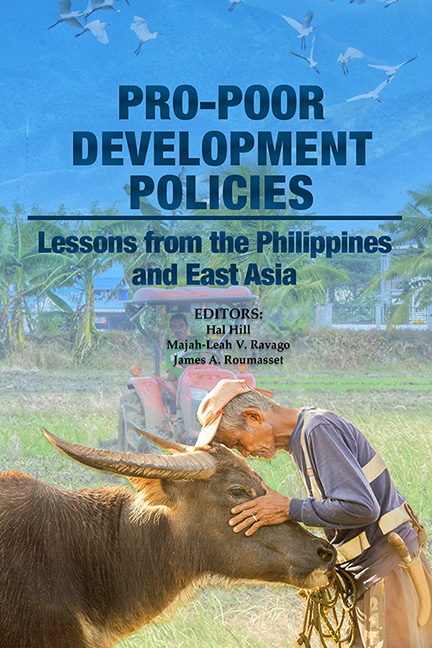Book contents
- Frontmatter
- Dedication
- Contents
- Figures, Tables and Boxes
- Foreword
- Foreword
- Message
- Preface and Acknowledgements
- About the Editors
- About the Contributors
- Acronyms
- Part 1 Introduction and Synthesis
- Part 2 Agricultural and Economic Development
- Part 3 Economic Policies for Achieving Targeted Levels of Living in the Philippines
- Part 4 Inequality and Economic Development
- Part 5 Competition Law and Policy
- Part 6 International Dimensions
- Index
12 - Reaching for the Demographic Dividend to Achieve Inclusive Economic Growth
Published online by Cambridge University Press: 09 January 2024
- Frontmatter
- Dedication
- Contents
- Figures, Tables and Boxes
- Foreword
- Foreword
- Message
- Preface and Acknowledgements
- About the Editors
- About the Contributors
- Acronyms
- Part 1 Introduction and Synthesis
- Part 2 Agricultural and Economic Development
- Part 3 Economic Policies for Achieving Targeted Levels of Living in the Philippines
- Part 4 Inequality and Economic Development
- Part 5 Competition Law and Policy
- Part 6 International Dimensions
- Index
Summary
BACKGROUND AND INTRODUCTION
The past seven decades, starting in the 1950s, have seen rapid changes in the population age structure of most countries across the world, notably in the Asia-Pacific region. This phenomenon, known as the demographic transition, had opened a window of opportunity for countries to experience rapid economic growth over a fairly long period, accompanied by poverty reduction. Backed by right policies on human capital, labour market, public health, infrastructure and governance, the demographic transition had accounted for a substantial portion of the economic growth—known as the demographic dividend—experienced by the “Asian tigers” (mainly South Korea, Taiwan and Singapore) from the early 1960s to the 1990s.
Demographic transition is the link between population dynamics (or changing age structure) and economic development. It denotes a change from a situation of high fertility and high mortality to one of low fertility and low mortality (Figure 12.1). A country that undergoes demographic transition experiences sizable changes in the age distribution of the population, which, in turn, positively influence economic growth, given the right socio-economic policies.
The demographic transition has three phases, each having a different impact on a country’s economic growth and development. The first phase is an initial decline in infant mortality (death rate), with fertility rate (birth rate) remaining high. This leads to an expansion in the number of children, resulting in increased demand for basic education, primary health care, nutrition, and other services. This was the situation in the Philippines in 2000 (Figure 12.2). The country had an increasing youth dependency ratio (population aged 0–14 years to total population), posing a challenge to the economy as scarce resources had to be channelled to consumption spending instead of investment from savings for economic growth (Mapa and Bersales 2008).
In the second phase, the proportion of working-age population (persons aged 15–64 years) is larger relative to the young dependents (aged 0–14 years) and the older population (65 years and above). This was the situation in Thailand in 2000 (Figure 12.3). The policy challenge in the second phase is how the labour market can absorb the increased working-age group, particularly those aged 15–24 years.
- Type
- Chapter
- Information
- Pro-poor Development PoliciesLessons from the Philippines and East Asia, pp. 311 - 338Publisher: ISEAS–Yusof Ishak InstitutePrint publication year: 2022

